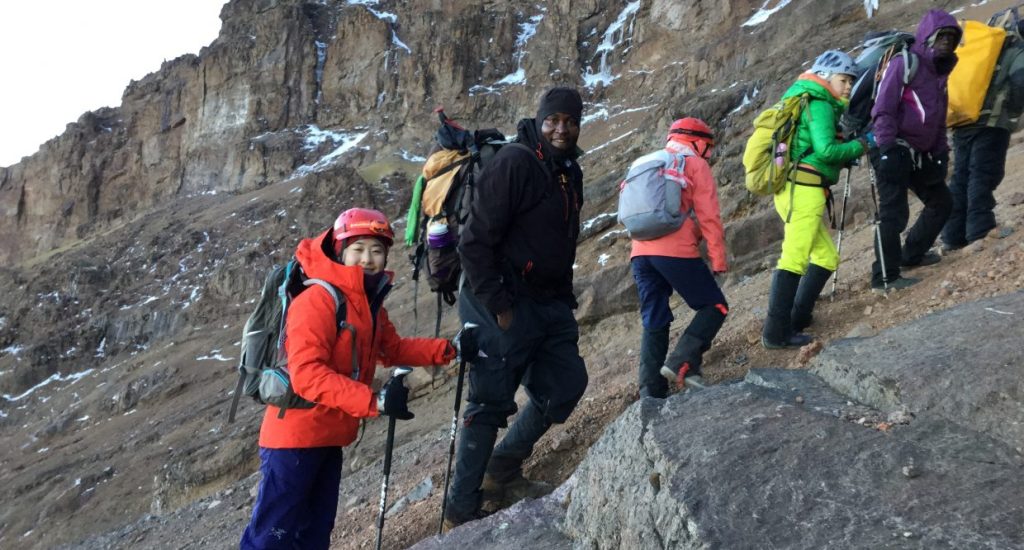6 Days Umbwe Climbing Route.
The Umbwe Route is for hikers looking for a serious climbing challenge. A quiet and rarely used trail that can be very challenging but at the same time very rewarding. This is the route if you want to test yourself on the slopes of Kilimanjaro and away from the crowds found on more normal trails.
 The Umbwe route is not a technical climb, but features steep climbs that require hikers to scramble over rocks and tree roots at certain points. This is the hardest and most direct route up the mountain, even featuring some exposed ridges not for the faint of heart. A hiker's fitness and stamina can be tested along the way, perfect for experienced mountain hikers looking for a challenge.
The Umbwe route is not a technical climb, but features steep climbs that require hikers to scramble over rocks and tree roots at certain points. This is the hardest and most direct route up the mountain, even featuring some exposed ridges not for the faint of heart. A hiker's fitness and stamina can be tested along the way, perfect for experienced mountain hikers looking for a challenge.
The Umbwe route is not technical, but it is very straight, very steep, very tough and sometimes very dangerous.
The Umbwe route joins the Machame route on the second night near Barranco camp. By other routes, the Barranco camp arrives on his third or fourth night. That shows how steep Umbwe is...
Parts of the trail on the first day are very steep and can only be managed as the tree roots provide what looks like stairs. Tree roots also act as handlebars to pull yourself up when you need to...
The second day is also steep and uphill. Bare ridges are not for those with a fear of heights...and guess why 'Rope Rock' (Jiwekamba) is called 'Rope Rock'...
This is the most difficult and demanding of the Kilimanjaro climbing routes. I can't imagine not having climbing experience.
That said, it's a spectacular route!
To get the most out of this climb, trekkers should be as fit and prepared as possible. This is a steady climb for the first few days, in contrast to other routes with slow steady climbs and up and down hikes. Adapt.
But the strenuous challenge of trekking the Umbwe route is compensated for by the spectacular scenery. As hikers climb the trail, they may see stunning views to the left and right. The early days of this trail offer perhaps the best views of any part of the mountain, except the summit.
Umbwe is also one of the quietest routes on Kilimanjaro. Due to its reputation for being a difficult climb, the trail is seldom used and remains open and relatively pristine.
This allows hikers to feel like they are the only ones on the mountain, until a few days after the start of the hike, until the route joins the Machame Route near Barranco Camp, from which the famous Mt. Southern He follows the circuit and makes his way to the top from his camp in Barrafus. As with most Kilimanjaro climbs, the descent follows the Mweka route.
If you are looking for the best views on your way to Kilimanjaro and want to test yourself in nature, Umbwe has it all on his route. The closest thing to a real climbing expedition on Kilimanjaro.
INCLUDES
• Mobile phones - carried by the main guide and all assistant guides, for daily communication with our Arusha base. For any emergency
• Linen (with replaceable bedding)
• Complete medical / first aid kit
• Professional mountain guides, all senior guides (at least one per trip) are currently certified by NOLS USA as WFR (Wilderness First Responder).
• A ratio of at least one guide for every three guests, to ensure personal attention.
• Cooks and porters
• Storage fees
• Camp fees
• Emergency rescue costs
• 4-season mountain tents (triple tent used as a double or single tent (extra charge), each tent equipped with a reinforced floor mat that covers both sides of the road, to allow clean and dry storage of equipment and waterproofing, mud or dust from entering the tent.
• Foam camping mat
• Large dining tent without weather, at night the tent is lit by candlelight, this tent is used for breakfast, lunch and dinner if the weather does not permit.
• Aluminum tables and chairs for all meals.
• Three meals a day, we prepare and prepare delicious and exciting meals needed for a long trip in the mountains.
• Snacks
• Tea and coffee
• Mineral water
• Transfer from the hotel to the starting point
• Transfer from the final destination to the hotel
EXCLUDES
- Accommodation on arrival and last day
- Mountain guide tips, recommended 15-20 per group per day
- Porters 5 - 10$ per porter per group per day
- Personal expenses
- Personal items
- Personal insurance / travel insurance
- Personal medicine/first aid kit
- Personal travel equipment
- Sleeping bag





